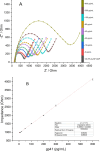Python-driven impedance profiling on peptide-functionalized biosensor for detection of HIV gp41 envelope protein
- PMID: 40599495
- PMCID: PMC12209138
- DOI: 10.1007/s13205-025-04400-8
Python-driven impedance profiling on peptide-functionalized biosensor for detection of HIV gp41 envelope protein
Abstract
This study presents the first label-free impedimetric biosensor for the detection of HIV envelope protein gp41 using antimicrobial peptides (AMPs) as biorecognition receptors. The biosensor interface was enhanced with thiolated polystyrene and gold nanospheres to ensure stable peptide immobilization and resist nonspecific adsorption. Electrochemical impedance spectroscopy (EIS) confirmed each step of the electrode modification, while surface morphology was validated via scanning electron microscopy. A Python-based deep learning algorithm was applied to impedance data for efficient curve fitting and regression modeling. The biosensor demonstrated high sensitivity, with a linear detection range of 5-600 pg/mL, a regression coefficient (R 2) of 0.9946, a limit of detection (LOD) of 1.62 pg/mL, and a limit of quantification (LOQ) of 4.91 pg/mL. Chronoimpedimetric (CI) detection revealed that gp41 binding occurred within 350 s. The biosensor showed excellent reproducibility (CV % = 0.22%), good selectivity with less than 12% signal variation in spiked serum, and robust stability, maintaining functionality after extended storage. These results highlight the biosensor's potential as a rapid, sensitive, and reproducible diagnostic platform for early HIV detection.
Supplementary information: The online version contains supplementary material available at 10.1007/s13205-025-04400-8.
Keywords: Biosensor; Gp41; HIV; Impedance; Python.
© The Author(s) 2025.
Conflict of interest statement
Conflict of interestThe authors declare no conflict of interests.
Figures







Similar articles
-
Fabrication and application of disposable 3D-printed gold electrodes for impedimetric biosensing of chemerin: a potential obesity biomarker.Anal Methods. 2025 Aug 18. doi: 10.1039/d5ay00970g. Online ahead of print. Anal Methods. 2025. PMID: 40824078
-
Engineered Antifouling Peptides with Sarcosine Branches for Robust Electrochemical Detection of the HER2 Biomarker in Real Biological Samples.ACS Sens. 2025 Jun 27;10(6):4074-4082. doi: 10.1021/acssensors.5c00082. Epub 2025 May 25. ACS Sens. 2025. PMID: 40415312
-
Development and synthesis of DNA-based label-free electrochemical biosensor for detection of Enterocytozoon bieneusi using screen-printed gold electrode.BMC Chem. 2025 Jul 2;19(1):184. doi: 10.1186/s13065-025-01547-6. BMC Chem. 2025. PMID: 40604918 Free PMC article.
-
Blood biomarkers for the non-invasive diagnosis of endometriosis.Cochrane Database Syst Rev. 2016 May 1;2016(5):CD012179. doi: 10.1002/14651858.CD012179. Cochrane Database Syst Rev. 2016. PMID: 27132058 Free PMC article.
-
Effectiveness of antiretroviral therapy in HIV-infected children under 2 years of age.Cochrane Database Syst Rev. 2012 Jul 11;(7):CD004772. doi: 10.1002/14651858.CD004772.pub3. Cochrane Database Syst Rev. 2012. Update in: Cochrane Database Syst Rev. 2014 May 22;(5):CD004772. doi: 10.1002/14651858.CD004772.pub4. PMID: 22786492 Updated.
References
-
- Chan DC, Fass D, Berger JM, Kim PS (1997) Core Structure of gp41 from the HIV envelope glycoprotein. Cell 89:263–273. 10.1016/S0092-8674(00)80205-6 - PubMed
-
- Conlin R, Erickson K, Abbate J, Kolemen E (2021) Keras2c: a library for converting Keras neural networks to real-time compatible C. Eng Appl Artif Intell 100:104182. 10.1016/J.ENGAPPAI.2021.104182
-
- Dai Y, Wei J, Qin F (2024) Recurrent neural network (RNN) and long short-term memory neural network (LSTM) based data-driven methods for identifying cohesive zone law parameters of nickel-modified carbon nanotube reinforced sintered nano-silver adhesives. Mater Today Commun 39:108991. 10.1016/J.MTCOMM.2024.108991
-
- Elalouf A, Maoz H, Rosenfeld AY (2024) Comprehensive Insights into the molecular basis of HIV glycoproteins. Appl Sci 14:8271. 10.3390/APP14188271
LinkOut - more resources
Full Text Sources

